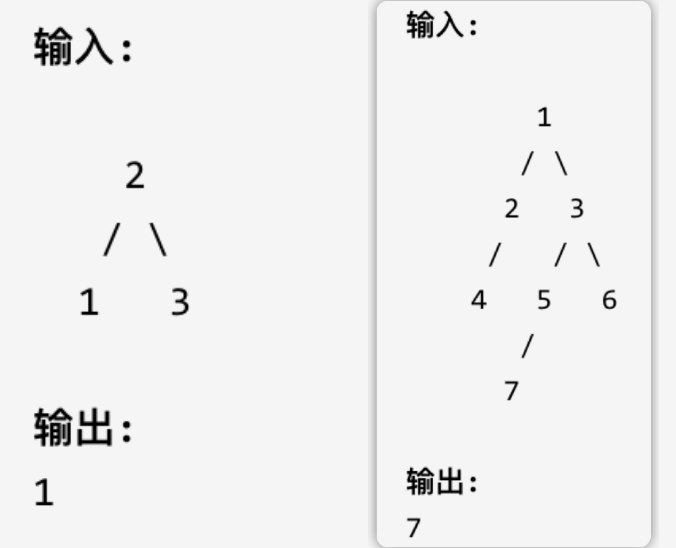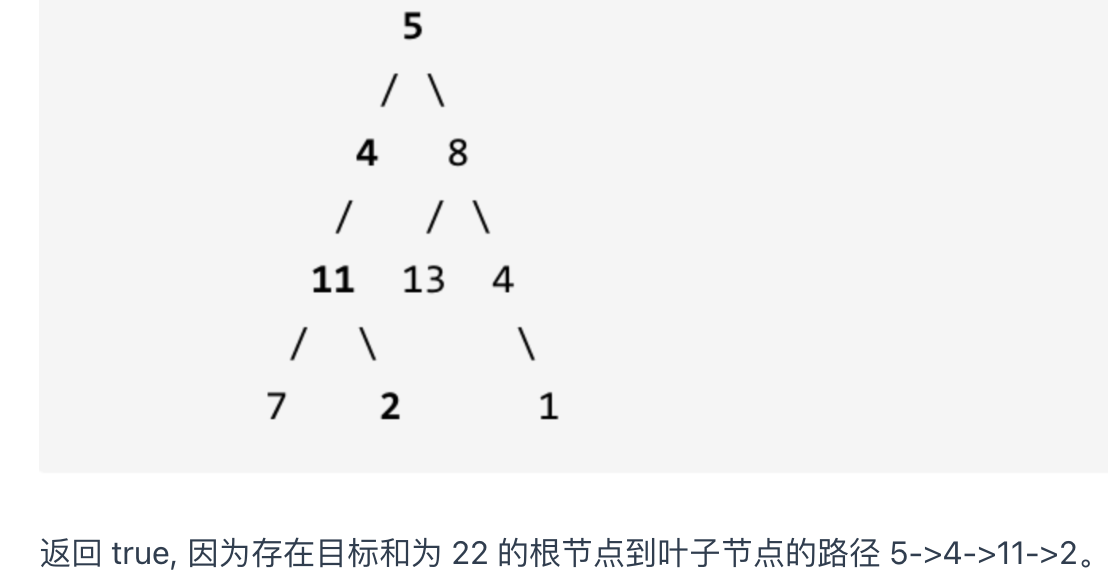day16 || lc513. 找树左下角的值 || lc112.路径总和 || lc106从中序和后续便利构造二叉树 || lc105_前序和中序构造二叉树
day16
lc513. 找树左下角的值
给定一个二叉树,在树的最后一行找到最左边的值。

树的最后一行 的 最左值
怎么找左下角呢?
只需要求深度最大的叶子节点 那么一定是最后一行 找到最后一行之后 使用前序便利 只要能保证左边优先进行搜索就行 然后记录最大的叶子节点 此时就是树的最后以后最左位置
递归法
class Solution {
int Deep = -1, value = 0;
public int findBottomLeftValue(TreeNode root) {
value = root.val;
findLeft(root ,0);
return value;
}
public void findLeft(TreeNode root, int d){
if(root == null) return;
if(root.left == null && root.right == null){
if(d > Deep){
value = root.val;
Deep = d;
}
}
if(root.left != null) findLeft(root.left, d + 1);
if(root.right != null) findLeft(root.right, d + 1);
}
}
迭代法
class Solution {
public int findBottomLeftValue(TreeNode root) {
Queue<TreeNode> q = new LinkedList<>();
q.offer(root);
int res = 0;
while(!q.isEmpty()){
int size = q.size();
for(int i = 0; i < size; i++){
TreeNode poll = q.poll();
if(i == 0) res = poll.val;
if(poll.left != null) q.offer(poll.left);
if(poll.right != null) q.offer(poll.right);
}
}
return res;
}
}
lc112.路径总和
给定一个二叉树和一个目标和,判断该树中是否存在根节点到叶子节点的路径,这条路径上所有节点值相加等于目标和。
说明: 叶子节点是指没有子节点的节点。
给定如下二叉树,以及目标和 sum = 22

注意: 是根节点到叶子结点的路径 只要有一条符合 那就是true
只要看到二叉树 就要想便利顺序 本题任何顺序都可以 因为不涉及根节点的处理逻辑 根节点放在哪里都可以
递归三部曲
- **确定返回值和参数 **
返回boolean类型 只要有符合的就返回 参数是跟节点root , 计数器int count ,这里直接传入目标值, 遇到一个节点就把节点数值做减法操作, 如果到叶子节点 count等于0了 说明符合
- 终止条件
如果跟是null 那直接返回false
遇到叶子节点 判断 左右孩子都是空 并且count等于0 就终止 return true
如果遇到叶子了 但是count不等于0 那说明不是符合的路径 return false;
- 单层递归的逻辑
向左便利 把目标值做减法 然后左递归
本题递归函数返回类型是Boolean 如果左方向返回true就符合继续return true
但是递归返回false说明不符合 那就回退回溯 回溯就把值加回来 然后向右便利递归
向右的逻辑和向左的一样 如果依然没有返回true 说明整个都不符合
综上: 只有左便利 右便利
public boolean hasPathSum(Node root, int targetSum) {
if(root == null) return false; //空的直接返回false
targetSum -= root.val; // 做减法
if(root.l == null && root.r == null) return targetSum == 0;
if(root.l != null){
boolean lv = hasPathSum(root.l, targetSum);
if(lv) return true;
}
if(root.l != null){
boolean rv = hasPathSum(root.r, targetSum);
if(rv) return true;
}
return false;
}
为什么刚刚提到了回溯要加回来 但是代码没有写出呢?
因为java中 基本数据类型是按值传递的, , 所以原始值不会变化
lc106从中序和后续便利构造二叉树
根据一棵树的中序遍历与后序遍历构造二叉树。 --- 中等
注意: 你可以假设树中没有重复的元素。
前序: 跟 左 右 中序: 左 跟 右 后序: 左 右 跟
中序是 9 3 15 20 7
后续是 9 15 7 20 3
- 找根节点
根据便利顺序 中序是左根右 后续是左右跟 后续的最后一个节点是跟 得出根节点是3
- 有跟之后看中序得出左右
找到根节点是3 那么看中序 根节点的前面就是左节点 也就是9 右节点是 15 20 7
- 再看后续得孩子顺序
在后续剩余的是15 7 20 这三个 后续最后节点是跟 也就是20 是跟
- 再去看中序
最后的三个在中序的顺序是 15 20 7 已经找到20是跟 那么 15是左 7是右
** 3**
** / **
** 9 20**
** / **
** 15 7**
综上: 在代码顺序为
- 后序数组为0的话 说明是空节点
- 找根 后序数组最后一个元素
- 寻找中序数组跟的位置作为切割点
- 切割中序数组 得出左右子树
- 切割后续
- 递归处理左右区间
然后递归三部曲
- 返回类型是 根据中和后构造二叉树的节点 参数是两个数组
- 后续数组为0 说明是空节点 return null
- 单层处理逻辑
- 后续数组的最后一个元素就是根节点 构造出根节点
- 找出根节点在中序数组的位置 int i = 0; for(i = 0; i < 中序长度; i++ ) if(中[i] == rootV) break; 此时break之后只留下i 也就是根节点在中序数组的下标位置
- 使用上一步的 i 切割中序 得出左右子树
- 使用中序数组左区间大小 切后续的左区间
注意:
在切割中序数组 以及后续数组 注意区间
切割中序 使用i 也就是后序数组最后一个元素根节点在中序的位置
切中序 使用的是中序数组的左区间大小 切 后续的左区间
public class Lc106_buildTree {
Map<Integer, Integer> m; //用来快速定位中序遍历中节点的索引位置。
public Node buildTree(int[] in, int[] post) {
m = new HashMap<>();
//用map保存中序序列的数值对应的位置
for(int i = 0; i < in.length; i++) m.put(in[i], i);
return findNode(in, 0, in.length, post, 0, post.length);
}
public Node findNode(int[] in, int inBegin, int inEnd, int[] post, int postBegin, int postEnd) {
//左闭右开 如果不满足 说明是空的
if(inBegin >= inEnd || postBegin >= postEnd) return null;
// 后续数组的最后一个元素 就是根节点 然后构造出来
int rootIndex = m.get(post[postEnd - 1]);
Node root = new Node(in[rootIndex]);
// 保存中序的左子树个数, 确定后续数组的个数
int lLength = rootIndex - inBegin;
root.l = findNode(in, inBegin, rootIndex, post, postBegin, postBegin + lLength);
root.r = findNode(in, rootIndex + 1, inEnd, post, postBegin + lLength, postEnd - 1);
return root;
}
}
注意本题的左右子树在中序和后序中的区间:
- **左子树:**
* 中序区间:`[inBegin, rootIndex)`
* 后序区间:`[postBegin, postBegin + lLength)`
- **右子树:**
* 中序区间:`[rootIndex + 1, inEnd)`
* 后序区间:`[postBegin + lLength, postEnd - 1)`
lc105_知道前序和中序构造二叉树
那么前序和中序能够构造二叉树吗?
前是跟左右 中是左跟右
根据前序数组 第一个就是根节点
/**
* lc105_找到前序和中序 还原二叉树 返回根节点
*/
public class Lc105_buildTreeQz {
Map<Integer, Integer> m;
public Node buildTree(int[] pre, int[] mid) {
m = new HashMap<>();
for(int i = 0; i < mid.length; i++) m.put(mid[i],i);
return findNodeII(pre,0,pre.length,mid,0,mid.length);
}
private Node findNodeII(int[] pre, int preB, int preE, int[] mid, int midB, int midE) {
if(preB >= preE || midB >= midE) return null;
int rootIndex = m.get(pre[preB]);
Node root = new Node(mid[rootIndex]);
int lLen = rootIndex - midB;
root.l = findNodeII(pre, preB + 1,preB + lLen + 1, mid, midB, rootIndex);
root.r = findNodeII(pre, preB + lLen + 1, preE, mid, rootIndex + 1, midE);
return root;
}
}
**但是知道后续和前序 不能构造二叉树 因为 后续是左右跟 可以得出跟在哪 前序是跟左右 **
关键是这俩左右是挨一块的 所以没办法分割区间


 浙公网安备 33010602011771号
浙公网安备 33010602011771号